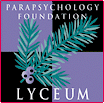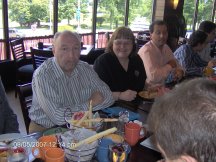 |
 |
| Holiday Inn Select, Halifax, Canada, August 2nd to 5th, 2007 by Peter Mulacz PF International Affiliate for Austria1  The 50th anniversary of the PA—serving half a century in and for the field—this is no small achievement. Hence my expectations were pitched rather high: I anticipated this convention to be the largest and most impressive ever. (The picture to the left is myself, PF’s Director of Publications Nancy Zingrone, and PF International Affiliate from Argentina, Alejandro Parra at the Affiliate Lunch held during the convention.) The 50th anniversary of the PA—serving half a century in and for the field—this is no small achievement. Hence my expectations were pitched rather high: I anticipated this convention to be the largest and most impressive ever. (The picture to the left is myself, PF’s Director of Publications Nancy Zingrone, and PF International Affiliate from Argentina, Alejandro Parra at the Affiliate Lunch held during the convention.)
Arriving a few hours late after a not-too-pleasant flight (the delay was caused by missing my connection flight due to the enhanced security checks in Heathrow airport) I found Halifax quite unchanged as if time had stopped for almost a decade: the same convention hotel where I had given a talk on the phenomena of Eleonore Zugun on the occasion of the PA Convention 1998, and even the same B&B in the vicinity with the lovely elderly lady who runs it still going strong. The first morning of the convention brought a big surprise to me: instead of the anticipated large crowd there was an audience of only less than fifty. (When the Austrian Society for Parapsychology hosted the PA Convention in 2004, we had more than 120 participants there.) However, it is not quantity, that counts, rather is it quality. And the quality of the papers, panels, and poster sessions was up to the usual PA standards and most definitely left nothing missing. The convention started with a historical panel, chaired by the PF’s own Carlos Alvarado, on “Forgotten Pioneers of Parapsychology”, of particular interest to me, to which I contributed a talk on Christoph Schröder who inherited Grunewald’s laboratory, ran a parapsychological institute and published several periodicals until 1941. One of his distinguished authors was Emil Mattiesen, the eminent theoretician of the survival issue, his life and work being covered by Eberhard Bauer. Gerd Hövelmann (incidentally the PF International Affiliate for Germany) gave a talk on Max Dessoir—the man who coined the very term “parapsychology”—a fascinating talk indeed as Hövelmann brought a number of hitherto unknown facets of Dessoir to light. The panel covered some other parapsychologists, too, who had been unknown to me before (and perhaps to the majority of European parapsychologists), like Rufus Osgood Mason, a US physician of the 19th century (Carlos Alvarado), the Argentinean surgeon and neurologist Orlando Canavesio (Alejandro Parra, also a PA International Affiliate), and, last not least, Charles Edward Stuart, an important member of J.B. Rhine’s research team at Duke, covered by the PF’s own Nancy Zingrone. While Sergio Schilling, the PA International Affiliate for Chile, gave an interesting talk on possession and trance, possibly linked to a recent wave of suicides within the youth of the Embera people, a small Colombian tribe, Alexander Moreira-Almeda looked into the problem whether spiritism was causing an epidemic of madness and insanity again from a historical perspective, reflecting the discussion of this issue in Brazil between the middle of the 19th to the 20th century™the question of psychohygiene has always been a burning problem in the context of parapsychology. In another talk, he compared similarities and differences between spiritualist mediums and patients suffering from Dissociative Identity Disorder, whereby the mediums turned out having better mental health and social adjustment. As altered states of consciousness apparently are known to be psi-conducive since the days of the early magnetizers, hypnosis is an issue in parapsychological research, too. Etzel Cardeña gave an interesting talk on a study using a neurophenomenological approach by analyzing both brain processes and consciousness during hypnosis with a sample of high, medium, and low hypnotizable participants. Interesting findings included a positive correlation between a global measure of brain functioning complexity and hypnotizability and, likewise, a positive correlation between this complexity and positive affect/mystical-akin phenomena and imagery. Inducing hypnosis had different effects on low and high hypnotizable subjects: frontal cortical activity increased in the low hypnotizable sample whereas it decreased in the high. Psi-conduciveness was also at the core of Nicola Holt’s talk on the relationship between creativity and psi, testing artists vs. “non-artists” using a new protocol, however, results remained non-significant. Caroline Watt, in her talk “A Peek in the File-Drawer”, reviewed some 100 unpublished student projects carried out at the KPU, Edinburgh, the majority of which obtained n/s results although psi effects were found in the “right” direction. Veteran parapsychologist Bill Roll gave two highly interesting papers on aspects of RSPK: on their Energetic Aspects, and on their Psychological and Neuropsychological Aspects. In the latter talk, seven well known cases (including Victor Gonzales, Roger Callihan, and Tina Resch) were discussed. Whereas the episodes of RSPK seemed to express anger as they disturbed people and damaged their property psychological tests did not always corroborate this. Interestingly the destructive side of RSPK surfaced only in the presence of father-figures, throwing light on the issue of the authority-sub¬ordina¬tion-relation (as I am inclined to call it, utilizing a term coined by the late Austrian psychiatrist Erwin Stransky) in the RSPK context. Several of the agents were medically diagnosed with various conditions. The fact that the movement of target objects could be observed was cross-checked against von Lucadou’s Model of Pragmatic Information. In his other talk, using as a starting point the late Hans Bender’s statement that in RSPK cases “psyche and matter are inextricably entangled”, Roll discussed the model of entanglement applied to large-scale objects. Also, he referred to the emission of bio-photons as established by William Joines with two RSPK subjects. Moreover, the concept of consciousness waves (PEAR Labs) was mentioned. For Roll, RSPK is, like quantum processes, a function of observation. Here is where an equivalent to Heisenberg’s uncertainty principle comes in: “When a person actually interacts with a nonlocal object in RSPK, the process may in part be described as entanglement and in part as energetic. The more is known about the movement of material objects without tangible aid, the more normal it seems, and the more we know about matter, the more paranormal it appears.” Summarizing, two very stimulating talks, food for thought … Space does not permit to mention each and every paper, let alone to comment on them, so I need to focus on what was most important – or rather, what I found most important from a very personal viewpoint, as this is my personal account. So, there were two more panels that must not go unmentioned: The first one was on the achievements of the recently deceased Ian Stevenson in the field, particularly on his research on the spontaneous cases, primarily but not limited to CORT (speakers including Nancy Zingrone, Erlendur Haraldsson, Carlos Alvarado, and John Palmer). Erlendur Haraldsson—perhaps the one who had been closest to Stevenson—made the point that Stevenson has (opposed to the traditional search for life after death) introduced a new field of enquiry: the investigation of phenomena pointing at evidence for life before birth, i.e. supporting the concept of reincarnation. What I find particularly intriguing is the issue of birthmarks and birth defects that appear to be related to past-life memories. Yet Stevenson’s research on spontaneous cases of ESP on one hand and mental mediumship on the other hand must not be neglected. (When in Halifax, Stevenson’s book on premonitions related the Titanic disaster comes to my mind.) Having looked that much into the past, the other panel that needs to be mentioned was looking towards the future of the field—as appropriate for an anniversary convention, looking Janus-faced both back and forward in time. This 50th Anniversary Assessment was chaired by the PA president, Rex Stanford, and included three statements on three different goals: Eberhard Bauer on the “Advancement of Parapsychology as a Science,” Stanley Krippner on the “Dissemination of the Knowledge of Parapsychology,” and Ed May on “The Integration of Parapsychology with other Branches of Science.” Bauer viewed the future of the field with moderate optimism (as I do), emphasizing the need to abandon outdated concepts like the “mind over matter” and to embrace the concept of treating psi phenomena as entanglement correlations in a generalized quantum theory (in the style of Harald Walach, now based in Northampton, and, as I may add, Hartmann Römer, Bonn, Germany). Stanley Krippner mentioned the antagonistic effects of rising production costs of printed periodicals vs. the new possibilities provided by internet-based resources (coincidentally the topic of contributions by Rick Berger and Analisa Ventola). Ed May stressed advances in statistics as well as the improvement of technology in automatic recording making us less dependent on subjects reporting their experiences. May closed his statements by citing famous Nobel price winning physicist Feynman—a famous quote, always worth to be borne in mind, and well suited as the concluding remark of my report on the PA anniversary convention: “It doesn’t matter how beautiful your theory is, it doesn’t matter how smart you are. If it doesn’t agree with experiment, it’s wrong.” P.S.: In order to mark the anniversary, Susie Radin surprised us by giving out her “original PA mini chocolate bars”—the sleeve designed and printed all by herself … ***************** 1. My participation in this conference was made possible by the “Incentive Award” travel grant of the PF for which I hereby express my gratitude to Ms. Lisette Coly. |
 |

|
 www. parapsychology. org |
||